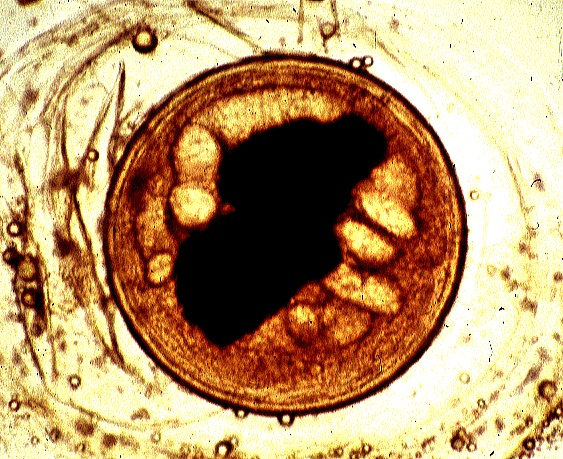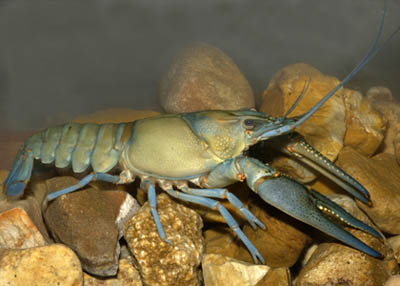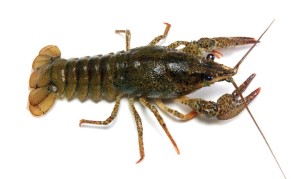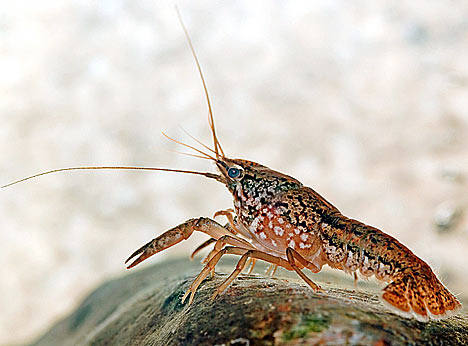Continuing the weird-things-people-do-with-food theme, doctors are warning people not to eat raw crayfish.
Physicians at Washington University School of Medicine in St. Louis have  diagnosed a rare parasitic infection in six people who had consumed raw crayfish from streams and rivers in Missouri. The cases occurred over the past three years, but three have been diagnosed since last September; the latest in April. Before these six, only seven such cases had ever been reported in North America, where the parasite, Paragonimus kellicotti, is common in crayfish.
diagnosed a rare parasitic infection in six people who had consumed raw crayfish from streams and rivers in Missouri. The cases occurred over the past three years, but three have been diagnosed since last September; the latest in April. Before these six, only seven such cases had ever been reported in North America, where the parasite, Paragonimus kellicotti, is common in crayfish.
"The infection, called paragonimiasis, is very rare, so it’s extremely unusual to see this many cases in one medical center in a relatively short period of time," says Washington University infectious diseases specialist Gary Weil, MD, professor of medicine and of molecular microbiology, who treated some of the patients. "We are almost certain there are other people out there with the infection who haven’t been diagnosed. That’s why we want to get the word out."
Paragonimiasis causes fever, cough, chest pain, shortness of breath and extreme fatigue. The infection is generally not fatal, and it is easily treated if properly diagnosed. But the illness is so unusual that most doctors are not aware of it.
The half-inch, oval-shaped parasitic worms at the root of the infection primarily travel from the intestine to the lungs. They also can migrate to the brain, causing severe headaches or vision problems, or under the skin, appearing as small, moving nodules.
The recent infections, which occurred in patients ages 10-32, have prompted the Missouri Department of Health & Senior Services to issue a health advisory alerting doctors across the state. The department also printed posters warning people not to eat raw crayfish and placed them in  campgrounds and canoe rental businesses near popular Missouri streams. Thoroughly cooking crayfish kills the parasite and does not pose a health risk.
campgrounds and canoe rental businesses near popular Missouri streams. Thoroughly cooking crayfish kills the parasite and does not pose a health risk.
Paragonimiasis is far more common in East Asia, where many thousands of cases are diagnosed annually in people who consume raw or undercooked crab that contain Paragonimus westermani, a cousin to the parasite in North American crayfish.
The crayfish is the State Invertebrate of Missouri. I’m not making this up.
 Inspection reports showed that Vibrio parahemolyticus had been detected in food samples provided both by Zheng Wen Qi Crayfish Donburi restaurant and its customers, Yangpu District government said on Friday.
Inspection reports showed that Vibrio parahemolyticus had been detected in food samples provided both by Zheng Wen Qi Crayfish Donburi restaurant and its customers, Yangpu District government said on Friday.
 had been boiled and served warm at a party. The chef reported that the boiled crayfish were served out of a cooler that had contained live crayfish, and the cooler had not been cleaned before being used to serve the cooked crayfish. After the party, the remaining crayfish were refrigerated overnight in different containers and served cold as leftovers the following evening on June 20.
had been boiled and served warm at a party. The chef reported that the boiled crayfish were served out of a cooler that had contained live crayfish, and the cooler had not been cleaned before being used to serve the cooked crayfish. After the party, the remaining crayfish were refrigerated overnight in different containers and served cold as leftovers the following evening on June 20.  diagnosed a rare parasitic infection in six people who had consumed raw crayfish from streams and rivers in Missouri. The cases occurred over the past three years, but three have been diagnosed since last September; the latest in April. Before these six, only seven such cases had ever been reported in North America, where the parasite, Paragonimus kellicotti, is common in crayfish.
diagnosed a rare parasitic infection in six people who had consumed raw crayfish from streams and rivers in Missouri. The cases occurred over the past three years, but three have been diagnosed since last September; the latest in April. Before these six, only seven such cases had ever been reported in North America, where the parasite, Paragonimus kellicotti, is common in crayfish. campgrounds and canoe rental businesses near popular Missouri streams. Thoroughly cooking crayfish kills the parasite and does not pose a health risk.
campgrounds and canoe rental businesses near popular Missouri streams. Thoroughly cooking crayfish kills the parasite and does not pose a health risk.